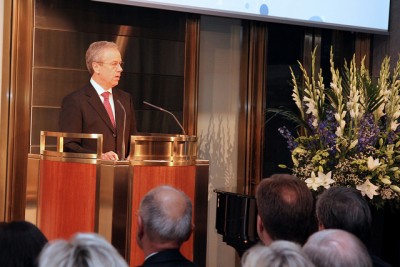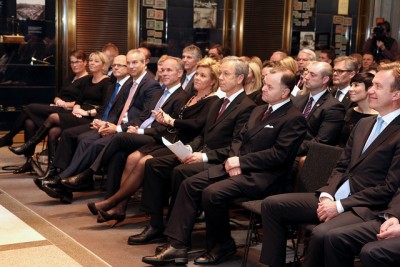UPDATED: The governor of Norway’s Central Bank (Norges Bank), Øystein Olsen, used his annual address in Oslo on Thursday evening not only to warn of “tougher times” ahead, but also against governments wantonly supporting banks on the brink of collapse. Norway bailed out its own biggest banks after a crisis at the end of the 1980s, but now Olsen thinks the country needs its own, separate national authority to deal with such trouble in the future.

The Norwegian central bank boss’ annual address, always attended by a virtual “who’s who” within the political and business world in Norway, traditionally covers a wide range of topics. This year’s address was entitled “Economic perspectives,” and Olsen noted how Norway’s economy is no longer so uniquely vibrant as it’s been in recent years, and that “tougher times” lie ahead. The strong growth spurred by record high oil prices in recent years, and the positive developments that led to in the entire petroleum and offshore sector, won’t continue, Olsen said.
“We cannot, and should not, base ourselves on thinking it will continue,” Olsen said, adding that “the winds are turning.”
Olsen also offered some new prospects for interest rates, predicting that they’ll stay low for even longer than previously expected. Newspaper Dagens Næringsliv (DN) reported that given the long-term rates in the market at present, Olsen thinks it probably will “take several years before interest rates here at home come up to what we earlier thought were normal levels.” He had thought “normal” was around 4-5 percent, but now he thinks that’s too high.
Olsen noted how lower oil prices and a slowdown in the real estate market are spurring Norwegian consumers to be more cautious. He also stressed how high costs and high wages in Norway can threaten Norway’s competitiveness, a topic that’s long been under debate and likely will play a major role in upcoming labour negotiations this spring.

On a broader scale, state broadcaster NRK noted how Olsen also raised the dilemma governments face when several banks risk failing at once. Payments stop, there are no loans for new investment and the economy becomes paralyzed, potentially prolonging a downturn. Olsen nonetheless feels that the option for the state to step in and prop up a bank is worse in the long run.
“Supporting banks in crisis may be necessary, but it has a major drawback,” Olsen told Norway’s most powerful public and private business and political leaders at the annual address, which was followed as usual by them mingling at a banquet at Oslo’s Grand Hotel. “Banks will have an expectation of help in the future.” He said the problem arises when banks’ lenders assume the government will step in to avert a crisis. The lenders therefore settle for a low interest rate on the money they’ve loaned. “Thus the risk is priced too low, and the risk taken in the banking system becomes too high,” he explained.
No bank lives forever
Olsen said systems are needed to ensure it’s a bank’s owners and lenders who foot the bill when a financial institution collapses. That has to happen internally, and at the state level, and it did in Norway when state regulators, for example, effectively bailed out what’s now Norway’s biggest bank, DNB. Private shareholders in the bank’s predecessor lost the value of their shares, while the state ended up as DNB’s major shareholder.
“Each individual bank should have a plan for how it can be liquidated in an orderly way,” Olsen recommended. “Large losses should be covered first by writing down the bank’s equity and debt.” He said banks’ lenders would then go in with new bank owners, making it possible to place a banks’ losses with both the lenders and owners. The most important banking services would not be disrupted.
Olsen also warned that no bank should be promised “eternal life” by governments. “We lack a system to liquidate banks in crisis,” he said. With Norway’s banks currently reporting record profits, however, there’s little prospect of any such liquidations looming any time soon.
National authority needed
Olsen said it’s critical that the reform efforts underway to protect financial institutions globally must be followed up in Norway. “A separate national authority to handle banks in crisis must be set up. It should be added to a unit under the Department of Finance,” he noted, saying it was not an appropriate role for the Central Bank.
At least one major political player was not present to heed Olsen’s advice. Prime Minister Erna Solberg drew criticism this week for choosing to head to the Winter Olympics in Sochi, rather than attending the annual official overview of the Norwegian economy by the country’s central banker, held every year since 1922. It’s only the third time a Prime Minister has missed the address, and it would have been Solberg’s first as leader. She was among the critics when former Prime Minister Jens Stoltenberg missed the speech seven years ago.
To read the governor’s speech in its entirety, click here (external link to Norges Bank).
newsinenglish.no/Emily Woodgate and Nina Berglund

